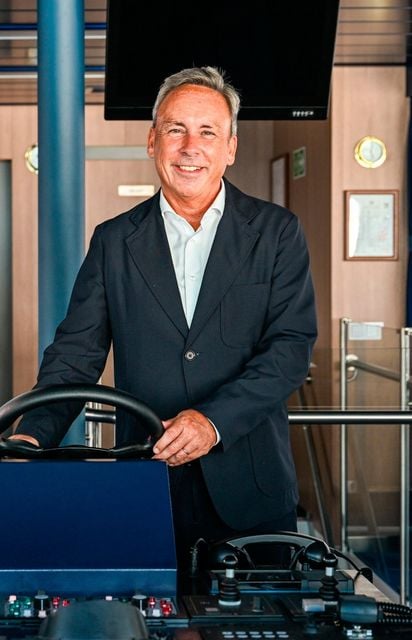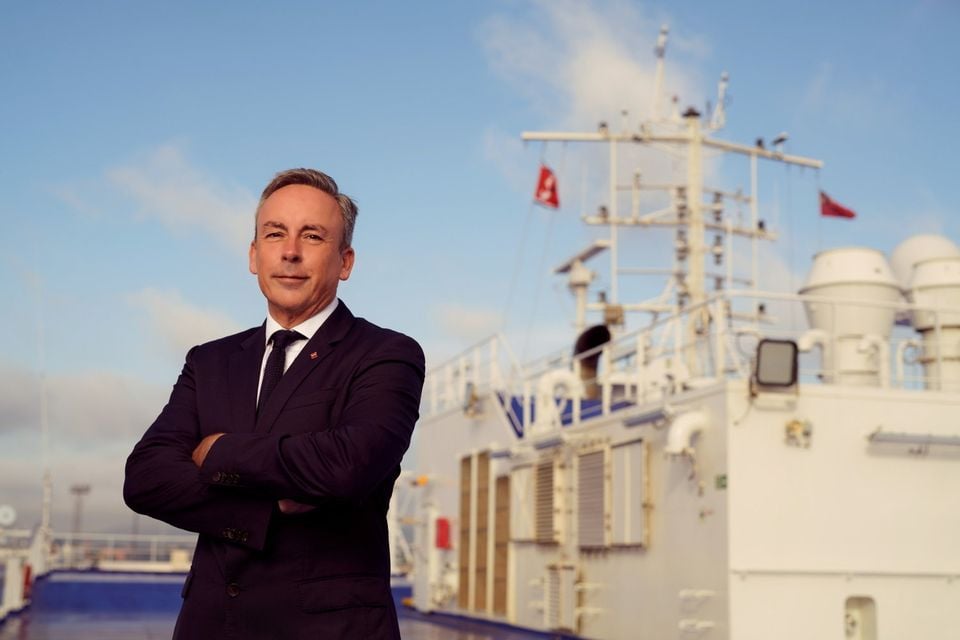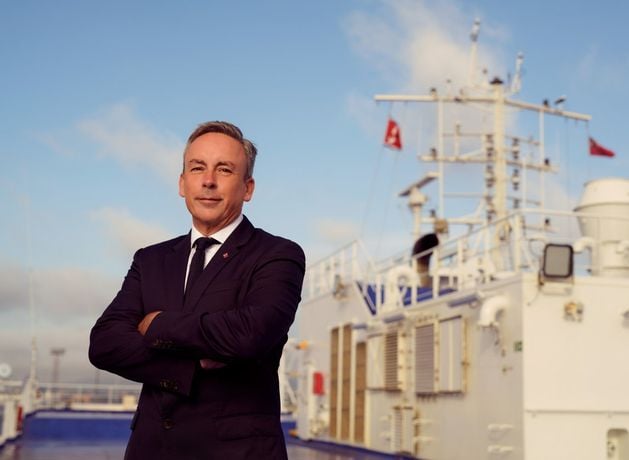Stena Line route manager Paul Grant on the challenges the firm has faced over 30 years
Paul Grant, 58, also spoke of his frustrations over political inaction on improvements to roads in Northern Ireland, including the Westlink in Belfast.
In the three decades since the move from Port of Larne to Belfast, Stena Line vessels have sailed 11.3 million nautical miles over 187,000. That’s enough travelling to take some around the world 523 times, or to the moon and back again over 50 times.
Those journeys have carried 43 million passengers, along with almost 10 million cars and about as many freight units.
The company generates a lot of revenue from businesses connected to the island of Ireland: the accounts for 2024 show that freight and passenger ferries between Ireland and the UK and Ireland and France generated £602m of turnover and profits before tax of £39m.
Looking back on the move to Belfast, Mr Grant says: “We moved from Larne to Belfast in 1995. We had three ships, but only one route. Now, in Belfast, we have seven ships and we serve three different destinations: Cairnryan, Heysham and Birkenhead.

Stena Line’s latest freight vessel, the Stena Futura
“During that time, the amount of freight that we’ve carried has increased fourfold. The amount of passenger traffic that we carry has increased 80% since then.”
Mr Grant acknowledges Stena Line is a private, for-profit company, but he views it as crucial to how NI functions in general.
“Stena is a big part of Northern Ireland’s infrastructure. We carry 80% of all the cars that travel back and forth between here and Britain. We carry almost 70% of the road freight that travels across.
“Belfast is now Stena Line’s biggest hub across Europe.”
“Without the ferry services, we would struggle to get food on the tables and we’d struggle to get the purchases that people are buying online.

Paul Grant, Stena Line Trade Director
“I think it became more prevalent to people during the Covid period, whenever people were cutting back on services.
“We weren’t able to cut back on services because, guess what, we’re a lifeline to Northern Ireland.
“Look at the population of Northern Ireland, you can see our penetration. There’s only 1.9 million in Northern Ireland, we carry 1.7 million on our ferries.”
Stena Line is long-lived in Belfast at this point, and Mr Grant is even longer-lived at the firm. He began straight out of university, at a business that would become part of Stena.
“When I started, it wasn’t Stena Line, it was a company called Sea Containers that were then taken over by Stena Line.
“I’ve worked in all different parts of the businesses; I have worked on the ships, on the ports, in different jobs throughout my career.”
Stena Line is a Swedish company, and is operated by the Olson family. Mr Grant views his owner as “massively committed” to Stena’s business across the Irish Sea.

Paul Grant has worked for Stena Line since before its move to Belfast
Paul Givan heckled by protesters as he faced vote of no confidence
Reflecting on the transition to Stena ownership, Mr Grant also believes the family-owned nature of the firm is still evident despite its size: “From early on, you could see the Stena Line values were completely different.
“We took a longer-term perspective on investments, there was a different culture in terms of how you look after colleagues and people.
“We were one of the first companies to actually run surveys of our employees. That’s become more prevalent in the last 10 or 20 years, but we were doing it 30 years ago.
“There’s a lot of good inherent values that came from the owner and how he ran his businesses.”
One of the biggest changes to face Stena Line’s business during its time in Belfast is Brexit. Despite the challenges faced by companies dealing with the bureaucratic realities of changing trade arrangements, Stena’s business in Belfast actually increased.
Initially, “some Northern Ireland hauliers would have left NI and went via Dublin to Holyhead into the UK.
“We’re now finding that some of those hauliers, because of the different problems that were might have been created for them in terms of documentation, have decided to switch their routes to, for example, Belfast to Liverpool or Belfast-Heysham
“More businesses are stopping in Northern Ireland. We’re probably carrying about 10% more freight out of Belfast than we did pre-Brexit.”
Mr Grant is very positive about the company he works for and the industry it is part of, but he has frustrations too.
In particular, he believes the road infrastructure leading to and from Belfast Harbour, and near Scottish ports, is insufficient and harms capacity.
“We’ve been talking about Westlink improvements for the best part of 30 years.
“We have invested more than £0.5bn in the last 30 years on improving infrastructure.
“But unfortunately, we haven’t seen the improvements on the Westlink and on that vitally important A75 road that connects Scotland with the M6.”
Asked about the impact of these delays, Mr Grant said you can see it “every day” with the difficulties facing hauliers at “that bottleneck we have on the Westlink.”
“That takes time, and time costs money. It can cause issues in our operation where, if there’s a traffic accident or jam, you can see people arriving late for their ferries or missing one sailing and having to go on another.”
He said that with the Westlink project and changes to the A75 in Scotland, Stena Line have seen “lots of talk and lots of promises from politicians, but unfortunately, we haven’t seen too many spades in the ground”.
A spokesperson for the Department for Infrastructure said: “In October 2022 the Department published a Placemaking and Active Travel Review report for the York Street Interchange project.
“Since then, officials have taken forward further work to refine the options within it.
“This work has now been completed, and a series of meetings have been held with elected representatives and other interested organisations, to gather their assessment of the report.
“The findings of this work have now been presented to the Minister who will take time to consider the next steps for this key infrastructure project.
“As the scheme is not funded through City and Growth deals and is not identified as an Executive Flagship project, officials will consider possible alternative funding methods which could facilitate the scheme progression.
“This work is at an early stage.”
